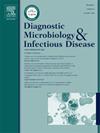Comparison of three different molecular biology assays (AllPlexTM H. pylori & ClariR assay, Amplidiag® H. pylori + ClariR and RIDA®GENE Helicobacter pylori) to detect Helicobacter pylori and clarithromycin resistance in stool samples
IF 2.1
4区 医学
Q3 INFECTIOUS DISEASES
Diagnostic microbiology and infectious disease
Pub Date : 2025-02-25
DOI:10.1016/j.diagmicrobio.2025.116771
引用次数: 0
Abstract
Helicobacter pylori detection and susceptibility profile using feces could optimize guided therapy, when endoscopy is not necessary. This study evaluated the performances of three tests: AllPlexH.pylori&ClariR, RIDAGENEHelicobacterpylori and AmplidiagH.pylori+ClariR assays on stool samples. Stool samples from a documented cohort (50 positive and 25 negative) were analyzed. The gold standard was a composite based on PCR targeting H. pylori and 23S rDNA mutations (A2142C, A2142G, A2143G) on gastric biopsies; and biopsy culture for H.pylori and susceptibility testing. For AllPlex, RidaGene and Amplidiag assays respectively: 55 (73.3%), 75 (100%), 54 (72%) samples could be analyzed; (for detection of H. pylori), sensitivity was 36% (95%CI]28;52%[); 32% (95%CI]21;46%[) and 93% (95%CI]87;100%[); specificity was 100% (95%CI]81;100%[), 83% (95%CI]68;91%[) and 57% (95%CI]33;79%[). (for the Clarithromycin resistance), sensitivity was 18% (95%CI]5;48%[), 25% (95%CI]9;53%[) and 67% (95%CI]39;86%[); specificity was 100% (95%CI]92;100%[). 92% (95%CI]83;97%[) and 97% (95%CI]89;99%[). Innovative technologies could become invaluable tools for mass testing after improvement.
求助全文
约1分钟内获得全文
求助全文
来源期刊
CiteScore
5.30
自引率
3.40%
发文量
149
审稿时长
56 days
期刊介绍:
Diagnostic Microbiology and Infectious Disease keeps you informed of the latest developments in clinical microbiology and the diagnosis and treatment of infectious diseases. Packed with rigorously peer-reviewed articles and studies in bacteriology, immunology, immunoserology, infectious diseases, mycology, parasitology, and virology, the journal examines new procedures, unusual cases, controversial issues, and important new literature. Diagnostic Microbiology and Infectious Disease distinguished independent editorial board, consisting of experts from many medical specialties, ensures you extensive and authoritative coverage.

 求助内容:
求助内容: 应助结果提醒方式:
应助结果提醒方式:


